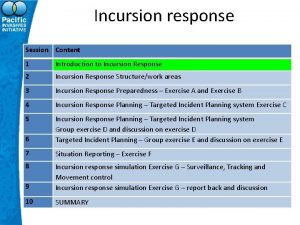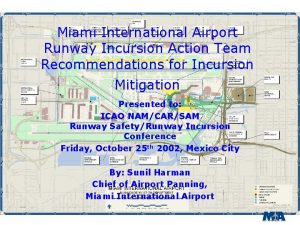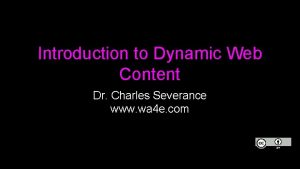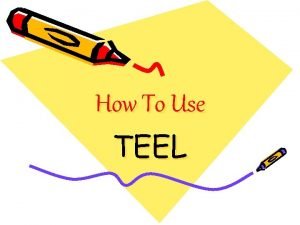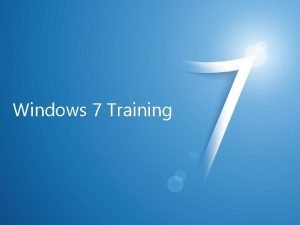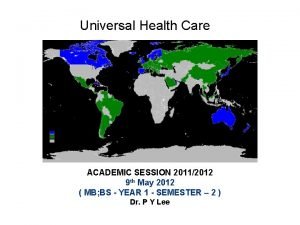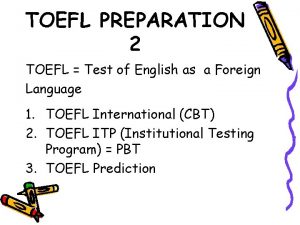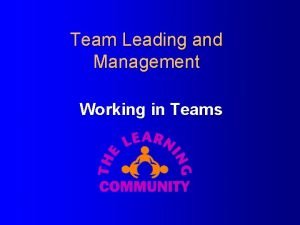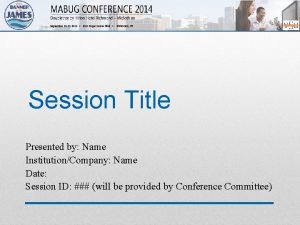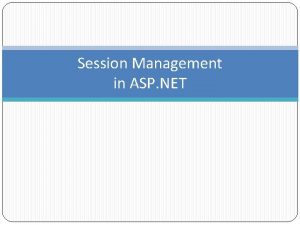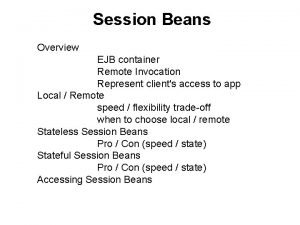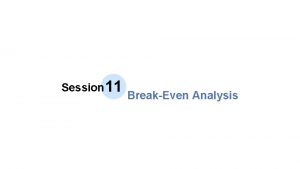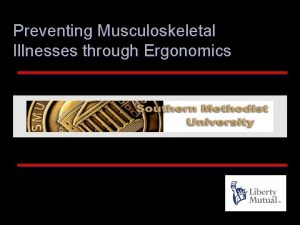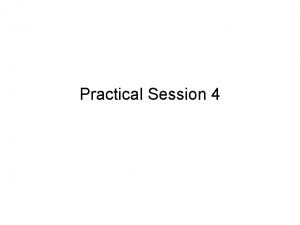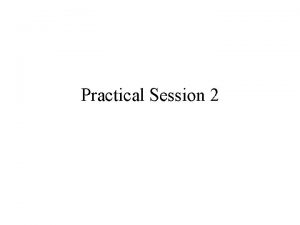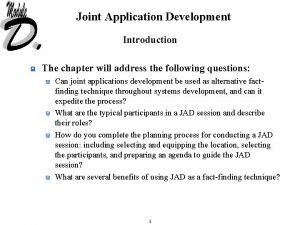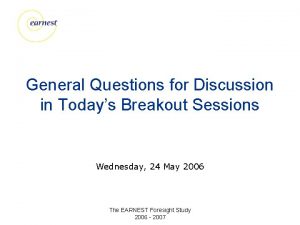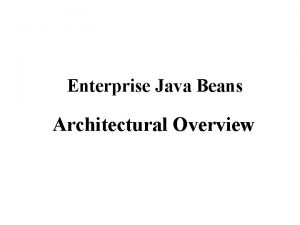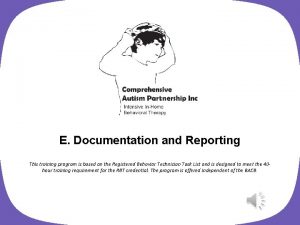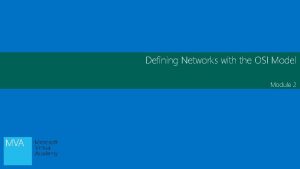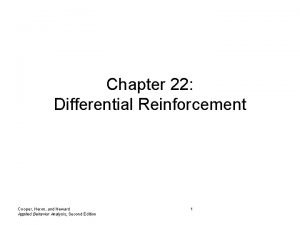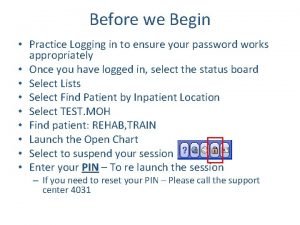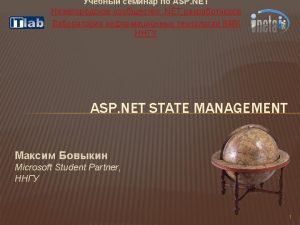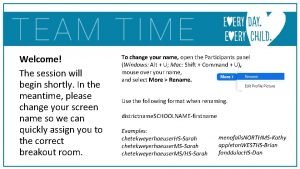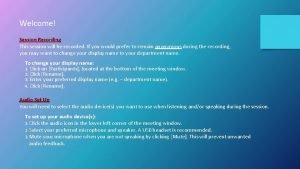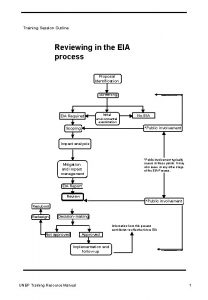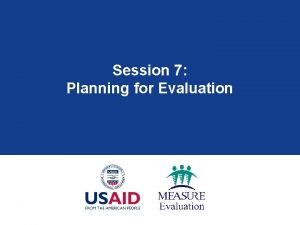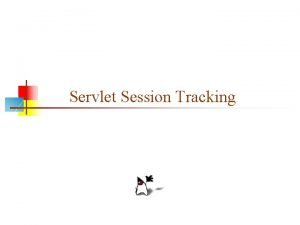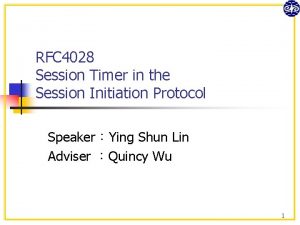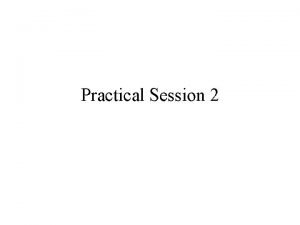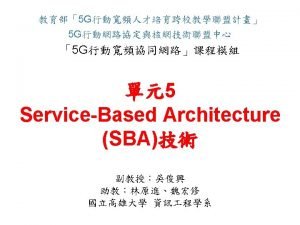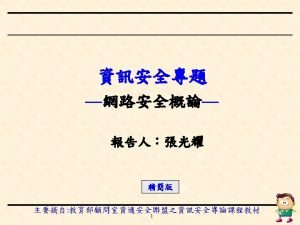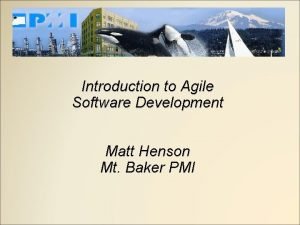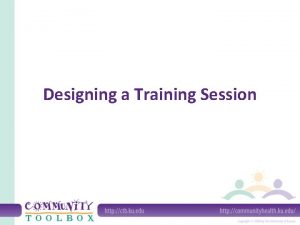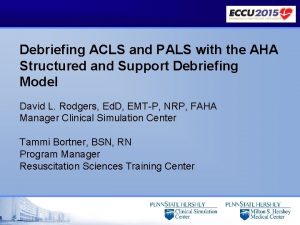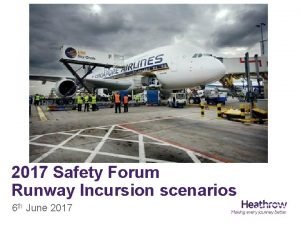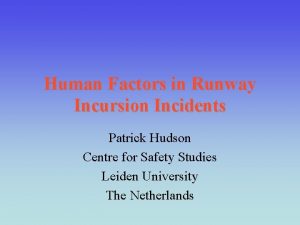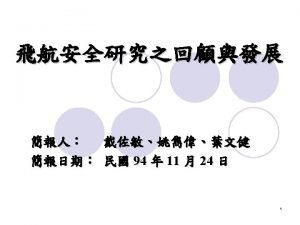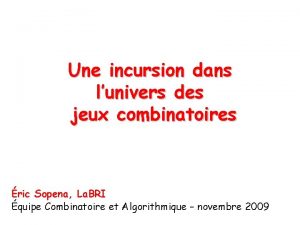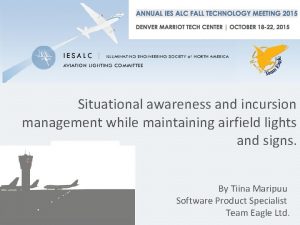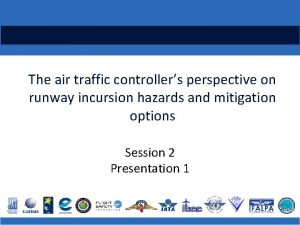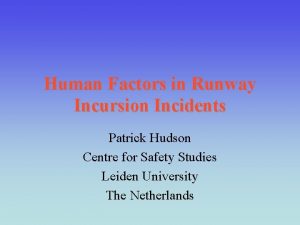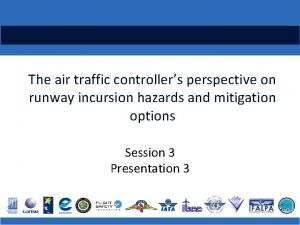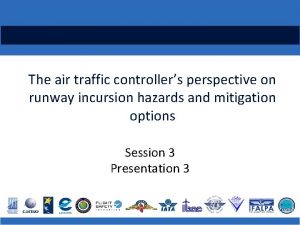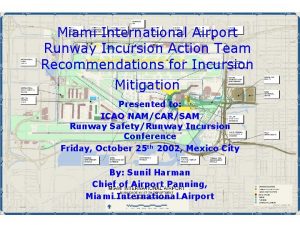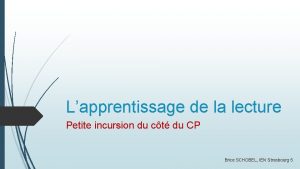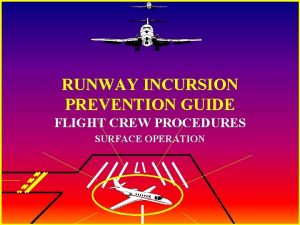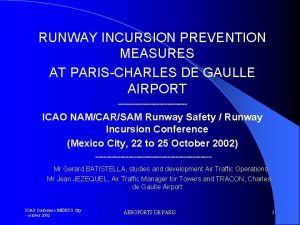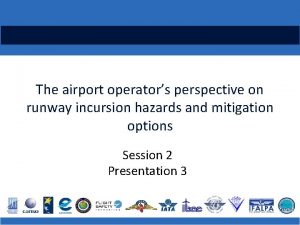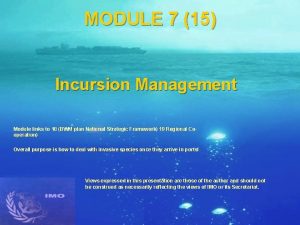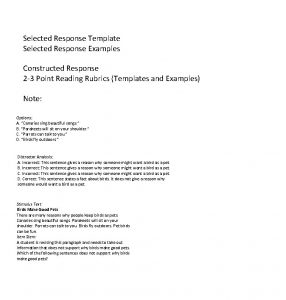Incursion response Session Content 1 Introduction to Incursion





































































- Slides: 69

Incursion response Session Content 1 Introduction to Incursion Response 2 Incursion Response Structure/work areas 3 Incursion Response Preparedness – Exercise A and Exercise B 4 Incursion Response Planning – Targeted Incident Planning system Exercise C 5 6 Incursion Response Planning – Targeted Incident Planning system Group exercise D and discussion on exercise D Targeted Incident Planning – Group exercise E and discussion on exercise E 7 Situation Reporting – Exercise F 8 9 Incursion response simulation Exercise G – Surveillance, Tracking and Movement control Incursion response simulation Exercise G – report back and discussion 10 SUMMARY

Arrival / establishment Incursion Response - definition here (ab first 2 we out the eks) There is informat ion in the PII w ebsite for this p art Initial response On-going response Focus is Detection Investigation

What we will do and learn – Work through the most important preparedness needed for a response – Know the main questions to ask after an invasive species detection (investigation) – Know the 3 + 4 work areas for a response – Know how to run a TIPS session (Incursion response planning) – Know how to plan for early response (surveillance, Tracking, movement control)

Arrival / Establishment • Invasive species arrive days, weeks, months and even years before detection • Prevention of their arrival is the MOST effective way to manage invasive species • Active surveillance and community awareness to detect them early is very important


Detection • • • Trap find Survey result Community awareness Phone call Ship-wreck “Noticed something different” Rat traps, Pohnpei Red imported fire ant, Texas Shipwreck • Write down what happened, and contact details Sheep, NZ

Investigation AIM: Investigate the detection to find out if it is a problem and if a response to manage the species is needed. QUESTIONS: 1. Is it an invasive species? • Diagnosis/Identification • DNA testing between original island populations or offshore introductions for eradicated species 2. Is it, or can it, cause harm? • • Where is it and what is it doing? Is it a known invasive species or closely related to one? Is it becoming a problem? What is at risk from it being present?

RIFA on yacht in NZ

Investigation Report - template • You will find a copy of an investigation report template in your folder.

Initial Response AIM: To stop or slow the invasive species from spreading, to plan, and gain enough information for a decision to manage the invasive species PLAN INFORMATION

Initial Response SETUP: • • • Scale-up people to deal with it Sort out communications Find out information Get expert advice Plan immediate response actions • • Surveillance Tracking Movement control Urgent Species Management • Plan resources needed

Red imported fire ant, Port of Napier NZ

Initial Response QUESTIONS: 1. Where did it come from? • Can you find out how it got here? 2. How long has it been here? • Can you work out the likely time period of arrival? • Days, months, years?


Initial Response • Where could it have spread to? • How does it spread on its own? • How do others spread it? (humans, animals, vehicles, vessels, soil, plants etc)

Example of plants arriving at airport, Samoa

On-going response • WHEN • If immediate actions did NOT remove the whole risk • If surveillance shows spread • If changes need to be made to stop it happening again • HOW • • • Get experts involved Feasibility study On-going management Refer to resources in the PII website: http: //www. pacificinvasivesinitiative. org/rk/index. html

Incursion response Session Content 1 Introduction to Incursion Response 2 Incursion Response Structure/work areas 3 Incursion Response Preparedness – Exercise A and Exercise B 4 Incursion Response Planning – Targeted Incident Planning system Exercise C 5 6 Incursion Response Planning – Targeted Incident Planning system Group exercise D and discussion on exercise D Targeted Incident Planning – Group exercise E and discussion on exercise E 7 Situation Reporting – Exercise F 8 9 Incursion response simulation Exercise G – Surveillance, Tracking and Movement control Incursion response simulation Exercise G – report back and discussion 10 SUMMARY

Response tasks (and Roles) 3 Incursion Manager Communication/ Liaison Species Management Movement Control Information Tracking Surveillance +4.

Response Tasks Incursion manager – Plan what needs to happen and lead a response team (if needed) Communications and liaison – Spokesperson to officials and community Information – Gather information on the invasive species biology and history Movement control – Stop spread while investigating Invasive species management – Urgent control of known problem, if needed Surveillance – Find out where it is and where it is not to help with species management Tracking – Look at risk pathways for spread, ask questions, decide if surveillance or management is needed in new areas

Incursion Manager • • Reports to senior officials Puts a team together when needed Leads planning of what needs to happen We will spend the afternoon practising incursion response planning

Communication / Liaison • Spokesperson for your team with officials and community • Works with team to develop the comms plan • Communication plan (comms plan) – Who needs to be informed? – Who needs to be involved in decisions? – Who can help and what do they need to know? – Who is going to be affected and what do they need to know? – Do we need surveillance comms (letting people know what to look for)?

Information • Information – Gather information on the invasive species’ biology and how it spreads Contact experts

Use existing resources

Species Management RIGHT NOW • Can the invasive species be eradicated or managed to reduce spread? • What are our options? – Trapping – Toxic baits etc • Are our options safe for people, native species, livestock, the environment?

Species Management (cont…) FUTURE INFORMATION • What are the safest options for eradication or longer term control? • Where can we get equipment or materials? • Based on surveillance results how much will it cost to manage the invasive species (important information for decision makers and funding groups)

Movement Control • Stop or slow down invasive species spread while information and surveillance is happening • Contain the problem until decisions to eradicate or control the invasive species are made

Tracking (Tracing) • Set time period of interest • Look at risk pathways for spread, ask questions, decide if surveillance is needed

Tracking - Argentine ant example International movement by travellers and goods and marshmallows? Local movement by bins Rubbish bins and pot plants Long distance movement by pot plants etc

Surveillance • Surveillance – – Find out where it is and where it is not Local spread surveillance (based on biology) Passive surveillance (local community) High risk site surveillance (Tracking)

Incursion Response Preparedness • Value of response preparedness? Preparedness Reduces the time between detection and action, for better outcomes and less cost

Lead agencies • A ‘lead agency’ is any organisation who has been given legal responsibility for managing an issue such as invasive species in a Country, Island or region. NZ example: Issue Lead Agency Support agency Human health threat Ministry of Health (Mo. H) Ministry for Primary Industries (MPI) Earthquake Civil defence Fire, Police, Defence, USAR, MPI, Mo. H Biosecurity threat Ministry for Primary industries Regional councils, Department of conservation, Mo. H Pacific examples?

Incursion response Session Content 1 Introduction to Incursion Response 2 Incursion Response Structure/work areas 3 Incursion Response Preparedness – Exercise A and Exercise B 4 Incursion Response Planning – Targeted Incident Planning system Exercise C 5 6 Incursion Response Planning – Targeted Incident Planning system Group exercise D and discussion on exercise D Targeted Incident Planning – Group exercise E and discussion on exercise E 7 Situation Reporting – Exercise F 8 9 Incursion response simulation Exercise G – Surveillance, Tracking and Movement control Incursion response simulation Exercise G – report back and discussion 10 SUMMARY

Incursion Response Preparedness • Exercises to prepare for the 3 + 4 response roles • Refer to preparedness booklets for each participant • 30 mins on exercise L (Incursion manager, communications, information) • 50 mins on exercise M (species management, movement control, surveillance, tracking) • Split into country or risk based groups of no more than 6 people • If necessary I can stay late and help complete the exercise

Preparedness – exercise L 3 Incursion Manager Communication/ Liaison Information Species Movement Tracking for Surveillance • Go over the first 3 work areas each country Management Control • Think about: +4. – lead agencies, likely role holders, key relationships, legislation, funding bodies, access to information and access to experts

Communication/ Liaison Preparedness – exercise M Species Management Movement Control Information Tracking Surveillance +4. Now go over last 4 roles/work areas for each country • Think about: – likely role holders, legislation, funding bodies, access to experts, resources, availability of equipment, tools • Much of the detailed planning in these roles or work areas will need to happen at the time of incursion. • PII have a Biosecurity plan template for specific invasive species preparedness with greater detail: http: //www. pacificinvasivesinitiative. org/rk/tools/T emplates. html

Incursion response Session Content 1 Introduction to Incursion Response 2 Incursion Response Structure/work areas 3 Incursion Response Preparedness – Exercise A and Exercise B 4 Incursion Response Planning – Targeted Incident Planning system Exercise C 5 6 Incursion Response Planning – Targeted Incident Planning system Group exercise D and discussion on exercise D Targeted Incident Planning – Group exercise E and discussion on exercise E 7 Situation Reporting – Exercise F 8 9 Incursion response simulation Exercise G – Surveillance, Tracking and Movement control Incursion response simulation Exercise G – report back and discussion 10 SUMMARY

Incursion Response Planning Targeted Incident Planning System (TIPS) was developed by the Emergency Management Academy of New Zealand (EMANZ) • Used by emergency services in NZ and for planning in Biosecurity responses • Purpose: – to put all the main issues down on paper and decide on options – To break the work up into achievable tasks and assign them to the person responsible


Incursion Response Planning Whole Group Exercise C • Situation: Yellow crazy ants • Incursion Manager: Karyn • Investigator: Monica (sit rep) • Response team: whole group

Incursion response Session Content 1 Introduction to Incursion Response 2 Incursion Response Structure/work areas 3 Incursion Response Preparedness – Exercise A and Exercise B 4 Incursion Response Planning – Targeted Incident Planning system Exercise C 5 6 Incursion Response Planning – Targeted Incident Planning system Group exercise D and discussion on exercise D Targeted Incident Planning – Group exercise E and discussion on exercise E 7 Situation Reporting – Exercise F 8 9 Incursion response simulation Exercise G – Surveillance, Tracking and Movement control Incursion response simulation Exercise G – report back and discussion 10 SUMMARY

Group Exercise D Situation: Something from the participants • Need some brief background on the detection of the invasive species (Participant to give brief sit rep) Group exercise: • Break into 2 Response Teams • Selected Incursion Manager to lead the planning session • Spend most time on the ‘factors’, ‘options’ and ‘tasks’ sections. • Report back to the whole group on how the planning went


Incursion response Session Content 1 Introduction to Incursion Response 2 Incursion Response Structure/work areas 3 Incursion Response Preparedness – Exercise A and Exercise B 4 Incursion Response Planning – Targeted Incident Planning system Exercise C 5 6 Incursion Response Planning – Targeted Incident Planning system Group exercise D and discussion on exercise D Targeted Incident Planning – Group exercise E and discussion on exercise E 7 Situation Reporting – Exercise F 8 9 Incursion response simulation Exercise G – Surveillance, Tracking and Movement control Incursion response simulation Exercise G – report back and discussion 10 SUMMARY

Group Exercise E Situation: Groups choose another current topic • Need some brief background on the detection of the invasive species (Participants to give brief sit rep) Group exercise: • Break into 3 Response Teams • Each team selects a new Incursion Manager to lead the planning session • Spend most time on the ‘factors’, ‘options’ and ‘tasks’ sections. • Report back to the whole group on how the planning went


Incursion response Session Content 1 Introduction to Incursion Response 2 Incursion Response Structure/work areas 3 Incursion Response Preparedness – Exercise A and Exercise B 4 Incursion Response Planning – Targeted Incident Planning system Exercise C 5 6 Incursion Response Planning – Targeted Incident Planning system Group exercise D and discussion on exercise D Targeted Incident Planning – Group exercise E and discussion on exercise E 7 Situation Reporting – Exercise F 8 9 Incursion response simulation Exercise G – Surveillance, Tracking and Movement control Incursion response simulation Exercise G – report back and discussion 10 SUMMARY

Situation reporting Normally hand written, delivered verbally or by fax/email Headings: • Situation – Organism; Notification details; Location (s); Risk description (what is currently known) • Actions taken – What actions (if any) have been taken to manage the risks • Actions to be completed – What actions are already underway or planned • Risks/issues – What is worrying us and who else needs to know • Recommended actions – Based on response planning • Map (if available) or drawing of location

Sit-rep Template • Hand out blank template and head outside for briefing.

Task – Sit rep • Based on a verbal briefing outside, participants are asked to fill in their own situation report • Each person should take notes during the briefing • Form into 3 groups and put together a situation report (should take no more than 10 minutes) • THEN – use your group report to brief the whole group (5 mins each)

Incursion response Session Content 1 Introduction to Incursion Response 2 Incursion Response Structure/work areas 3 Incursion Response Preparedness – Exercise A and Exercise B 4 Incursion Response Planning – Targeted Incident Planning system Exercise C 5 6 Incursion Response Planning – Targeted Incident Planning system Group exercise D and discussion on exercise D Targeted Incident Planning – Group exercise E and discussion on exercise E 7 Situation Reporting – Exercise F 8 9 Incursion response simulation Exercise G – Surveillance, Tracking and Movement control Incursion response simulation Exercise G – report back and discussion 10 SUMMARY

Incursion Response YCA Simulation • Group 1. Surveillance – visit the forestry plot to see what area you are dealing with then plan surveillance to detect natural spread and implement in field (Monica to take in forestry plot) • Group 2. Tracking – visit forestry plot and determine high risk movements that may have spread the invasive species. Make a Tracking plan, including time period of interest. Practice interviewing people (Bill to take) • Group 3. Movement control – field visit to forestry plot to determine risk movements (Souad to take) then develop a plan of how to reduce spread from the infested site • Take a TIPS form with you in case your team wants to use it to plan their activities. • If preferred we could swap to do a comms plan or an urgent species control plan for the same scenario.

Simulation Group 1 - Surveillance plan What to consider: • Natural spread – Length of time org likely to have been present – How org spreads – Habitat preferences • Tracking results – Where else should we look for human assisted spread? (you will need to go and ask the Tracking team for this information) • Surveillance Plan – Trap density, number, how often checked, diagnostics – What is the case definition (what do we call ‘positive’ ants in a trap, 1 ant on a trail or a nest? ) – What is the denominator? (plants, m 2, villages, traps? )

Simulation Group 2 – Tracking high risk movements What to consider: • Looking for human assisted movements – How long is it likely to have been here (timeline) (talk with surveillance team) – What is it capable of being transported in? – What are the highest risk transport items –food, soil etc. – Draw timeline with movements on it arrowed out to a decision. – Decision on what to do with each ‘trace’ (set up surveillance, public awareness, alert offshore authorities, treat or survey receiving areas)

Simulation Group 3 - Tracking (diagram tool) What could have caused the incursion – may want to improve offshore procedures Where else could the pest have moved to after arrival? Arrival Detection Movement control in place Time period of interest = _____ Imported goods Fishing boats Tourist boats Soil from another part of the Island Potted plants Recommend better off-Island biosecurity Fishing boats to other bays, ports or islands Earth moving equipment Rubbish dump Goods /plants taken to other parts of the island Recommend surveillance/ treatment

Movement control plan What to consider: • Does surveillance indicate a single nest/population or wider? • Can we eradicate or control the invasive species while we find out more about spread? • What can we use? (Legal, community support, awareness, direct requests not to move risk items) • What are the issues with these options and the area we are dealing with (business, tourists, local community, garden waste, rubbish, trucks, soil) • Where do we get help for a really big incursion needing movement control for a long time?

Incursion response Session Content 1 Introduction to Incursion Response 2 Incursion Response Structure/work areas 3 Incursion Response Preparedness – Exercise A and Exercise B 4 Incursion Response Planning – Targeted Incident Planning system Exercise C 5 6 Incursion Response Planning – Targeted Incident Planning system Group exercise D and discussion on exercise D Targeted Incident Planning – Group exercise E and discussion on exercise E 7 Situation Reporting – Exercise F 8 9 Incursion response simulation Exercise G – Surveillance, Tracking and Movement control Incursion response simulation Exercise G – report back and discussion 10 SUMMARY

Groups to report back • 20 mins for each group to explain how they planned and what was in the plan. • Group 1 • Group 2 • Group 3

Incursion response Session Content 1 Introduction to Incursion Response 2 Incursion Response Structure/work areas 3 Incursion Response Preparedness – Exercise A and Exercise B 4 Incursion Response Planning – Targeted Incident Planning system Exercise C 5 6 Incursion Response Planning – Targeted Incident Planning system Group exercise D and discussion on exercise D Targeted Incident Planning – Group exercise E and discussion on exercise E 7 Situation Reporting – Exercise F 8 9 Incursion response simulation Exercise G – Surveillance, Tracking and Movement control Incursion response simulation Exercise G – report back and discussion 10 SUMMARY

Summary of key points • Preparedness reduces the time between detection and action. • Planning for a response is important (TIPS) • Stop or reduce spread while you get enough information to make decisions • Get help from other agencies or countries to manage a big invasion

End of Incursion Response session

Extra information slides • The following slides are only information slides if needed to prompt ideas

Spread risk variables ASSUMPTION – small but viable population e. g. overwintering adults so no population growth but viable 1 st area - starting point • Population size • Single population or multiple populations • Seasonality • Phenology

Spread risk variables 2 nd area – physical attributes of environment • Weather patterns, wind • Nature of environment • Natural barriers e. g. channel between islands

Spread risk variables 3 rd area - biological attributes of species itself • Fast breeder • Obligate vectors • How will natural enemies impact • Natural dispersal or by humans (speed of dispersal) • What size has the bottleneck been? Does it have enough genetic variability to spread • Allee effect

Spread risk variables 4 th area - how quickly you might find it • How visible is it naturally? • Is it a pathogen – non-symptomatic pathogen? • Specific surveillance in place? • Suitable diagnostic tests available? • Are we looking in the right place? • What do public do? Do they realise it’s a threat? E. g. Asian knotweed • Are your containment factors effective?

Spread mitigation • • • • Current management practise Aerial spraying EARLY DETECTION! Active surveillance Passive surveillance Good biosecurity practicesinternal Existing natural enemies Management control Movement control restrictions Public awareness Grower awareness Nursery biosecurity Moving biological material Grafting protocols Response simulations/exercises Biosecurity plans for soil Vector control Landscape diversity Host removal Wind screens Diagnostic tools Scientific capability and responsiveness • Response plans • • •

Establishment risk variables • Climate where establishment may occur • Season/time of year • Resource availability (e. g. hosts) - distribution and density. • Physical environment e. g. whether the environment is managed or unmanaged • Allee effect (male + female x? ? ) • Detection • Human assisted spread e. g. supermarket chains, human behaviours etc. • Use of product that risk is on e. g. garlic from China for consuming that is planted and carry disease

Definitions • Case definition- a positive find should be counted the same throughout the surveillance period. e. g. Ants in a bait trap or live ant nests or active ant trails (you can select whichever one makes the most sense to count but don’t count all three as meaning the same thing, they are different) • Population at risk – give a relevant denominator by using units of interest. E. g. Surveillance was undertaken in 10 m 2 grids covering 150 m 2. We detected ants in 4 bait traps = 4/150 m 2.
 Incursion definition
Incursion definition Runway excursion statistics
Runway excursion statistics Rrsit
Rrsit What is esp
What is esp Static content vs dynamic content
Static content vs dynamic content Natural and forced response
Natural and forced response Natural response circuit
Natural response circuit A subsequent
A subsequent Introduction to dynamic web content
Introduction to dynamic web content Introduction to content management system
Introduction to content management system Introduction to dynamic web content
Introduction to dynamic web content Content introduction
Content introduction Analytical text structure
Analytical text structure Text response essay structure
Text response essay structure Text response introduction example
Text response introduction example Richa goyal
Richa goyal Teel essay structure
Teel essay structure Session 0 isolation
Session 0 isolation Welcome to new session 2020-21
Welcome to new session 2020-21 Session
Session During a biology laboratory session
During a biology laboratory session Team norming session
Team norming session 6 session name
6 session name Session name
Session name Asp.net session management
Asp.net session management Stateful session bean life cycle
Stateful session bean life cycle Session break even
Session break even Eis portal principal per session
Eis portal principal per session Ergonomics session
Ergonomics session Factor label definition
Factor label definition Practical session definition
Practical session definition Definition of session in php
Definition of session in php Pdp staff
Pdp staff Circle k #45067
Circle k #45067 Advantages of joint application development
Advantages of joint application development Poster imrad
Poster imrad Sample minutes of lac session
Sample minutes of lac session Ece329
Ece329 Hkn review
Hkn review Breakout session questions
Breakout session questions Facilitate learning session
Facilitate learning session Stateful session bean life cycle
Stateful session bean life cycle Listening session template
Listening session template Ece 120 uiuc
Ece 120 uiuc Rbt soap note example
Rbt soap note example Session protocol data unit
Session protocol data unit Full session drl aba
Full session drl aba Session layer protocols
Session layer protocols Meditech suspend session icon
Meditech suspend session icon Alpha session 8
Alpha session 8 V$active_session_history
V$active_session_history Asp net session state
Asp net session state Prayer for planning session
Prayer for planning session Will begin shortly
Will begin shortly This session will be recorded
This session will be recorded Training session outline
Training session outline Name of the session
Name of the session Instagram
Instagram Session 7
Session 7 Session tracking in servlet
Session tracking in servlet Sip session timer
Sip session timer Practical session definition
Practical session definition 5g pdu
5g pdu Osi model
Osi model Session 1 research simulation task
Session 1 research simulation task Baker session agile
Baker session agile Coaching session agenda
Coaching session agenda Training session design
Training session design Pals debriefing session
Pals debriefing session Word 2016 session 2 post assessment
Word 2016 session 2 post assessment
